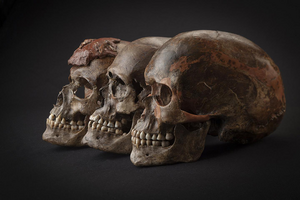Game of bones? Ancient genes uncover prehistoric European drama.
Researchers gathered genetic data from 51 early modern humans and found evidence of population turnover and waves of migration during European prehistory, driven by advancing and retreating glaciers.

Three ~31,000-year-old skulls from Dolni Vestonice in the Czech Republic. For the next twenty thousand years, all samples analyzed in this study – whether from Belgium, the Czech Republic, Austria, or Italy – are closely related, reflecting a population expansion associated with the Gravettian archaeological culture.
Courtesy of Martin Frouz and Jirí Svoboda/Institute of Archaeology/Czech Academy of Science
A new study sheds light on the genetic composition of early modern humans, who arrived in Europe about 45,000 years ago and lived for millennia alongside our extinct cousins, the Neanderthals.
In analyzing DNA from the ancient bones – 45,000 to 7,000 years old – of 51 of these prehistoric humans, an international team of scientists found evidence of population turnover and waves of migration during European prehistory, driven by advancing and retreating glaciers. The last ice age peaked between 25,000 and 19,000 years ago, at which time glaciers covered Scandinavia and northern Europe.
“The demographic history of early European populations was much more dynamic than previously thought,” said Cosimo Posth, an archaeogenetics PhD student at the University of Tübingen in Germany, reported New Scientist.
He and his fellow authors of a paper published May 2 in the journal Nature reported that the genetic patterns they found in their analysis show that all of their specimens younger than 37,000 years old, gathered from across Europe and western Asia, descended from a single population. Today's Europeans also share genes with this population.
So far, it doesn’t appear that people who lived before these prehistoric humans contributed genetically to today’s Europeans, write the paper’s authors.
This branch of early humans was displaced from most parts of the continent by 33,000 years ago, the researchers say, but then reappeared around 19,000 years ago, as the ice sheet retreated, when their descendants in the Iberian peninsula (modern-day Spain and Portugal) began to spread throughout Europe.
Then, in a second major population shift that coincides with a warming climate after the Ice Age, about 14,000 years ago, populations from places such as today’s Turkey and Greece spread north and west into Europe, displacing the first group.
"What we see is a population history that is no less complicated than that in the last 7,000 years," said David Reich, a paper co-author and geneticist from Harvard Medical School, "with multiple episodes of population replacement and immigration on a vast and dramatic scale, at a time when the climate was changing dramatically."
The researchers also found that the proportion of Neanderthal DNA in Europeans from 45,000 years ago declined from between 3 to 6 percent to about 2 percent in Europeans today. The paper authors propose that natural selection reduced Neanderthal ancestry over time.
"Neanderthal DNA is slightly toxic to modern humans," said Dr. Reich in a statement.
Before this study, genomic data were available from only four prehistoric Europeans, which made it impossible to develop an accurate picture of how human populations migrated or evolved during this period.
“Trying to represent this vast period of European history with just four samples is like trying to summarize a movie with four still images,” Reich said. “With 51 samples, everything changes; we can follow the narrative arc; we get a vivid sense of the dynamic changes over time,” he said.

